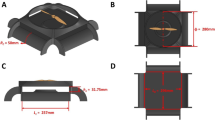Abstract
This work presents the nonlinear dynamical model and motion controller of a system consisting of an unmanned aerial vehicle (UAV) that is tethered to a floating buoy in the three-dimensional (3D) space. Detailed models of the UAV, buoy, and the coupled tethered system dynamics are presented in a marine environment that includes surface water currents and oscillating gravity waves, in addition to wind gusts. This work extends the previously modeled planar (vertical) motion of this novel robotic system to allow its free motion in all three dimensions. Furthermore, a directional surge velocity control system (DSVCS) is proposed to allow both the free movement of the UAV around the buoy when the cable is slack, and the manipulation of the buoy’s surge velocity when the cable is taut. Using a spherical coordinates system centered at the buoy, the control system commands the UAV to apply forces on the buoy at specific azimuth and elevation angles via the tether, which yields a more appropriate realization of the control problem as compared to the Cartesian coordinates, where the traditional x-, y-, and z-coordinates do not intuitively describe the tether’s tension and orientation. The proposed robotic system and controller offer a new method of interaction and collaboration between UAVs and marine systems from a locomotion perspective, and offers a low-cost and low-logistics alternative to crewed vessels for marine missions. It has potential applications in search-and-rescue missions, monitoring and sensing operations, and floating objects manipulation and retrieval. The system is validated in a virtual high-fidelity simulation environment, which was specifically developed for this work, while considering various settings, operating conditions, and wave scenarios.








Similar content being viewed by others
Data availability statement
The datasets generated and/or analyzed during the current study are available in the Github repository: github.com/AUBVRL/3D-Tethered UAV–buoy, along with the simulation environment that is available as a MATLAB/Simulink\(\circledR \) project.
References
Abeywickrama, H.V., Jayawickrama, B.A., He, Y., et al.: Comprehensive energy consumption model for unmanned aerial vehicles, based on empirical studies of battery performance. IEEE Access 6, 58383–58394 (2018). https://doi.org/10.1109/ACCESS.2018.2875040
Bingham, B., Aguero, C., McCarrin, M., et al.: Toward maritime robotic simulation in gazebo. In: Proceedings of MTS/IEEE OCEANS Conference, Seattle, WA (2019)
Choi, S.Y., Choi, B.H., Jeong, S.Y., et al.: Tethered aerial robots using contactless power systems for extended mission time and range. In: 2014 IEEE Energy Conversion Congress and Exposition (ECCE), IEEE, pp. 912–916 (2014). https://doi.org/10.1109/ECCE.2014.6953495
Dicembrini, E., Scanavino, M., Dabbene, F., et al.: Modelling and simulation of a tethered UAS. In: 2020 International Conference on Unmanned Aircraft Systems (ICUAS), pp. 1801–1808 (2020). https://doi.org/10.1109/ICUAS48674.2020.9214006
Dufek, J., Murphy, R.: Visual pose estimation of usv from uav to assist drowning victims recovery. In: 2016 IEEE International Symposium on Safety, Security, and Rescue Robotics (SSRR), pp. 147–153 (2016). https://doi.org/10.1109/SSRR.2016.7784291
Faltinsen, O.M.: Sea Loads on Ships and Offshore Structures. Cambridge University Press, Cambridge (1990)
Fossen,T.I.: Guidance and Control of Ocean Vehicles. Wiley (1995)
Foxtech.: FOXTECH T3500 Plus Tethered Power System. (2020). https://www.foxtechfpv.com/foxtech-t3500-plus-tethered-power-system.html, [Online; accessed 14-May-2021]
Fridsma, G.: A systematic study of the rough-water performance of planing boats. Tech. rep., Davidson Laboratory Report 1275, Stevens Institute of Technology, (1969). https://apps.dtic.mil/sti/citations/AD0708694
Gonzalez-Garcia, A., Miranda-Moya, A., Castañeda, H.: Robust visual tracking control based on adaptive sliding mode strategy: Quadrotor UAV - catamaran USV heterogeneous system. In: 2021 International Conference on Unmanned Aircraft Systems (ICUAS), pp. 666–672, (2021). https://doi.org/10.1109/ICUAS51884.2021.9476707
Han, Y., Ma, W.: Automatic monitoring of water pollution based on the combination of UAV and USV. In: 2021 IEEE 4th International Conference on Electronic Information and Communication Technology (ICEICT), pp. 420–424 (2021). https://doi.org/10.1109/ICEICT53123.2021.9531204
Jung, S., Cho, H., Kim, D., et al.: Development of algal bloom removal system using unmanned aerial vehicle and surface vehicle. IEEE Access 5, 22166–22176 (2017). https://doi.org/10.1109/ACCESS.2017.2764328
Kominami, T., Paul, H., Miyazaki, R., et al.: Active tethered hook: Heavy load movement using hooks that move actively with micro UAVs and winch system. In: 2021 IEEE/ASME International Conference on Advanced Intelligent Mechatronics (AIM), pp. 264–269 (2021). https://doi.org/10.1109/AIM46487.2021.9517518
Kourani, A., Daher, N.: Bidirectional manipulation of a buoy with a tethered quadrotor UAV. In: 2021 IEEE 3rd International Multidisciplinary Conference on Engineering Technology (IMCET), pp. 101–106 (2021). https://doi.org/10.1109/IMCET53404.2021.9665578
Kourani, A., Daher, N.: Leveraging PID gain selection towards adaptive backstepping control for a class of second-order systems. In: 2021 American Control Conference (ACC), pp. 1174–1179 (2021). https://doi.org/10.23919/ACC50511.2021.9483159
Kourani, A., Daher, N.: Marine locomotion: a tethered UAV-buoy system with surge velocity control. Robot. Auton. Syst. 145(103), 858 (2021). https://doi.org/10.1016/j.robot.2021.103858
Kourani, A., Daher, N.: A tethered quadrotor UAV-buoy system for marine locomotion. In: 2021 IEEE International Conference on Robotics and Automation (ICRA), pp. 59–65 (2021). https://doi.org/10.1109/ICRA48506.2021.9560878
Kourani, A., Daher, N.: A practical guideline for designing and tuning adaptive backstepping controllers for a class of second-order systems based on pid similarity. Int. J. Dyn. Control (2022). https://doi.org/10.1007/s40435-022-00922-8
Krishna, C.G.L., Cao, M., Murphy, R.R.: Autonomous observation of multiple USVs from UAV while prioritizing camera tilt and yaw over uav motion. In: 2017 IEEE International Symposium on Safety, Security and Rescue Robotics (SSRR), pp. 141–146 (2017). https://doi.org/10.1109/SSRR.2017.8088154
Liu, Y., Zhang, F., Huang, P., et al.: Analysis, planning and control for cooperative transportation of tethered multi-rotor UAVs. Aerosp. Sci. Technol. 113(106), 673 (2021). https://doi.org/10.1016/j.ast.2021.106673
Lupashin, S., D’Andrea, R.: Stabilization of a flying vehicle on a taut tether using inertial sensing. In: 2013 IEEE/RSJ International Conference on Intelligent Robots and Systems, pp. 2432–2438 (2013). https://doi.org/10.1109/IROS.2013.6696698
Nicotra, M.M., Naldi, R., Garone, E.: Taut cable control of a tethered UAV. IFAC Proc. Vol. 47(3), 3190–3195 (2014). https://doi.org/10.3182/20140824-6-ZA-1003.02581
Ozkan, M.F., Carrillo, L.R.G., King, S.A.: Rescue boat path planning in flooded urban environments. In: 2019 IEEE International Symposium on Measurement and Control in Robotics (ISMCR), pp. 221–229 (2019). https://doi.org/10.1109/ISMCR47492.2019.8955663
Saleh, M., Oueidat, G., Elhajj, I.H., et al.: In situ measurement of oil slick thickness. IEEE Trans. Instrum. Meas. 68(7), 2635–2647 (2019). https://doi.org/10.1109/TIM.2018.2866745
Shao, G., Ma, Y., Malekian, R., et al.: A novel cooperative platform design for coupled USV-UAV systems. IEEE Trans. Ind. Inf. 15(9), 4913–4922 (2019). https://doi.org/10.1109/TII.2019.2912024
Talke, K.A., De Oliveira, M., Bewley, T.: Catenary tether shape analysis for a UAV - USV team. In: 2018 IEEE/RSJ International Conference on Intelligent Robots and Systems (IROS), pp. 7803–7809 (2018). https://doi.org/10.1109/IROS.2018.8594280
Tognon, M., Franchi, A.: Dynamics, control, and estimation for aerial robots tethered by cables or bars. IEEE Trans. Robot. 33(4), 834–845 (2017). https://doi.org/10.1109/TRO.2017.2677915
Tutsoy, Ö.: Cpg based rl algorithm learns to control of a humanoid robot leg. Int. J. Robot. Autom. (2015). https://doi.org/10.2316/Journal.206.2015.2.206-4185
Wang, N., Ahn, C.K.: Coordinated trajectory tracking control of a marine aerial-surface heterogeneous system. IEEE/ASME Trans. Mech. (2021). https://doi.org/10.1109/TMECH.2021.3055450
Xing, L., Liu, X., Zhang, S.: The vibration characteristics analysis of the tethered UAV system. Yingyong Lixue Xuebao/Chin. J. Appl. Mech. 38(1), 106–112 (2021). https://doi.org/10.11776/cjam.38.01.C075
Xu, Z.: Application research of tethered UAV platform in marine emergency communication network. J. Web Eng. 20(2), 491–512 (2021). https://doi.org/10.13052/jwe1540-9589.20212
Zhang, J., Xiong, J., Zhang, G., et al.: Flooding disaster oriented USV and UAV system development and demonstration. In: OCEANS 2016 - Shanghai, pp. 1–4 (2016). https://doi.org/10.1109/OCEANSAP.2016.7485676
Zhang, J., Gu, D., Ren, Z., et al.: Robust trajectory tracking controller for quadrotor helicopter based on a novel composite control scheme. Aerosp. Sci. Technol. 85, 199–215 (2019). https://doi.org/10.1016/j.ast.2018.12.013
Acknowledgements
This work is supported by the University Research Board (URB) at the American University of Beirut (AUB).
Funding
This work is supported by the University Research Board (URB) at the American University of Beirut (AUB).
Author information
Authors and Affiliations
Contributions
All authors contributed to the study’s conception and design. Material preparation and data collection were performed by AK, analysis was performed by AK and ND. The first draft of the manuscript was written by AK and all authors commented on subsequent versions of the manuscript. All authors read and approved the final manuscript.
Corresponding author
Ethics declarations
Conflict of interest
The authors have no relevant financial or non-financial interests to disclose.
Additional information
Publisher's Note
Springer Nature remains neutral with regard to jurisdictional claims in published maps and institutional affiliations.
Appendices
Appendix A: Buoy inertia and damping matrices
The buoy’s inertia matrix in the world frame \(\mathcal {W}\), \(\mathbf {M}_{\mathrm {b}}\), is symmetric (i.e., \(M_{ij} = M_{ji}\), for \(i\ne j\)), and has its nonzero elements explicitly given as:
Similarly, its damping matrix in \(\mathcal {W}\), \(\mathbf {D}_{\mathrm {b}}\), is symmetric (i.e., \(D_{ij} = D_{ji}\), for \(i\ne j\)), and has its nonzero elements explicitly given as:
Appendix B: UAV inertia matrix
The UAV’s inertial matrix in \(\mathcal {W}\) is symmetric, with elements explicitly expressed as:
Appendix C: Spherical coordinates details
The spherical coordinates transformation to Cartesian coordinates, \(\mathbf {R}_{\mathrm {S2C}}\), is made by two ordered rotations, \(\mathbf {R}_{\alpha }\) then \(\mathbf {R}_{\varphi }\), where:
and:
By differentiating \(\mathbf {r}\) with respect to time, we find the derivatives of the spherical unit vectors to be:
From the definition of the spherical coordinates system and from (C6), the position, velocity, and acceleration vectors of \(\mathcal {O}_{\mathrm {u}}\) are given by:
The components of the UAV’s thrust vector in the spherical frame are explicitly realized from (26) as:
With the taut cable condition in (30), we have \(\mathrm {r}=l\), and the spherical coordinates of the UAV with respect to the buoy’s center of mass, \(\mathcal {O}_{\mathrm {b}}\), reduced to:
Based on Assumption 5, we can simplify (C9) to:
which then expands to:
and similarly, its velocity can be obtained as:
which expands to:
Appendix D: Euler–Lagrange formulation
The Kinetic energy of the tethered UAV–buoy system, \(\mathcal {K}\), includes the rotational and translational energies of the UAV and that of the buoy while neglecting the cable’s energy, and is explicitly described as:
The kinetic energy is differentiated with respect to each state rate then with respect to time. Only the buoy’s translational states and tether’s orientation states are of interest, since the UAV and the buoy’s rotational states feature no dependencies on other states, which can be seen by inspection of the expanded \(\mathcal {K}\). Their corresponding results are expressed as:

The differentiation results of the UAV and buoy’s rotational states are omitted as they result in similar components to the rotational dynamics already introduced in (27) and (21).
The kinetic energy of the system is differentiated with respect to the states, (\(\frac{\partial \mathcal {K}}{\partial \varvec{\eta }}\)), where the resulting nonzero elements are obtained as:
Notice that most elements of \(\frac{\partial \mathcal {K}}{\partial \varvec{\eta }}\) cancels out with elements of \(\frac{d}{dt}\Big (\frac{\partial \mathcal {K}}{\partial \dot{\varvec{\eta }}} \Big )\).
The system’s potential energy was given in (38), and its external forces and moments vector can be formulated based on (22) and (28) as:
Additionally, we have: \(\varvec{\tau }_{6-8} = \varvec{\tau }_{2,\mathrm {u}}\) and \(\varvec{\tau }_{9-11} = \varvec{\tau }_{2,\mathrm {b}}\). The potential energy’s derivative with respect the states rates then to time is obtained as:
and its first derivative with respect to states is obtained as:
Rights and permissions
Springer Nature or its licensor holds exclusive rights to this article under a publishing agreement with the author(s) or other rightsholder(s); author self-archiving of the accepted manuscript version of this article is solely governed by the terms of such publishing agreement and applicable law.
About this article
Cite this article
Kourani, A., Daher, N. Three-dimensional modeling of a tethered UAV–buoy system with relative-positioning and directional surge velocity control. Nonlinear Dyn 111, 1245–1268 (2023). https://doi.org/10.1007/s11071-022-07918-1
Received:
Accepted:
Published:
Issue Date:
DOI: https://doi.org/10.1007/s11071-022-07918-1




